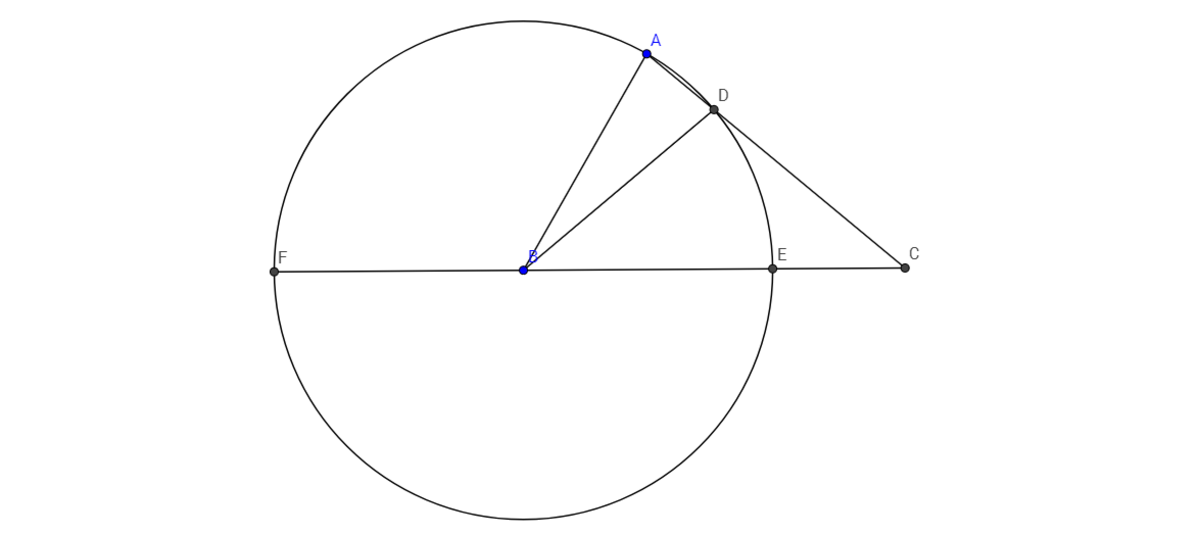ABC problem?
In △ A B C , we have A B × A C = B C 2 − A B 2 . If ∠ A B C = θ radians, it follows that ∠ B C A = r p π − q θ radians, where p , q and r are positive integers. What is the minimum possible value of p + q + r ?
The answer is 5.
This section requires Javascript.
You are seeing this because something didn't load right. We suggest you, (a) try
refreshing the page, (b) enabling javascript if it is disabled on your browser and,
finally, (c)
loading the
non-javascript version of this page
. We're sorry about the hassle.
2 solutions
Please correct me if I am wrong somewhere in the below mentioned my thought procedure.
We can deduce that bc = a^2 - c^2 ............................(i)
=> bc=(a-c)(a+c)
Case 1: a-c = b and a+c = c
We can observe that a+c =c implies a=0, but as the triangle exists, this is false.
Case 2: a-c = c and a+c = b
This implies a = 2c and (2c) + c =b OR a = 2c and b = 3c.
Also, When we apply cosine formula for angle C and using the equation (i) , we get, Cos(C) = (b+c)/2a = (3c + c)/4c = 1
This implies that C needs to even multiple of Pi. Hence, we get that this triangle can never be formed because C has to be 0, 2*Pi and so on,
none of which can satisfy as an angle of a Triangle.
P.S : This conclusion that I have come to feels kinda weird to me
Log in to reply
Just because ( a + c ) ( a − c ) = b c , we cannot deduce that a + c must be one of b or c .
Let ∠ B C A = x . As shown below, we consider a circle of radius A B centred at B . Suppose this circle intersects B C at two points E and F :

Note that A B × A C = B C 2 − A B 2 can be rewritten as:
A B × A C = ( B C − A B ) ( B C + A B )
Considering that A B = B E as both represent the radius of the circle,
A B × A C = ( B C − B E ) ( B C + B E )
A B × A C = C E × C F
Now employing the properties of circles,
C D × A C = C E × C F as the two lines from point C intersect the circle at A , D , E and F . It then follows that A B = C D . Consdering that A B = B D , this means that B D = C D and hence ∠ C B D = ∠ B C D = x .
Then ∠ A D B = ∠ C B D + ∠ B C D = x + x = ( 1 + 1 ) x = 2 x .
Next A B = B D as both represent the radius of the circle so ∠ B A D = ∠ A D B = 2 x .
Finally,
∠ B A C + ∠ B C A + ∠ A B C = π
2 x + x + θ = π
( 2 + 1 ) x = π − θ
3 x = π − θ
x = 3 π − θ
Therefore, p = 1 , q = 1 and r = 3 which means p + q + r = 5 as required.
Nice problem, but why did you delete your other problem amazing angle ?
The Cosine Rule a 2 = b 2 + c 2 − 2 b c cos A c 2 = a 2 + b 2 − 2 a b cos C together with the given condition a 2 − c 2 = b c tells us that b = c ( 1 + 2 cos A ) cos C = 2 a b + c Putting these two statements together, and using the Sine Rule, we have cos C sin A cos C − cos A sin C sin ( A − C ) = a c ( 1 + cos A ) = sin A sin C ( 1 + cos A ) = sin C = sin C Since A , C are angles in a triangle, we deduce that A − C = C , so that A = 2 C , and hence C = 3 1 ( π − B ) = 3 1 ( π − θ ) . Thus the answer is 1 + 1 + 3 = 5 .